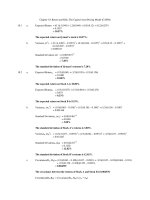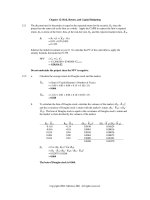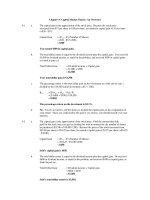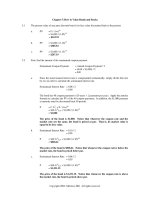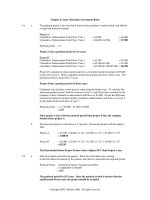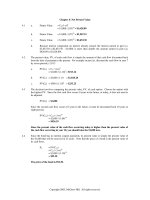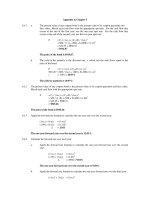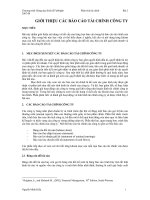Tài liệu Tài chính doanh nghiệp ( Bài tập)_ Chapter 16( V1) ppt
Bạn đang xem bản rút gọn của tài liệu. Xem và tải ngay bản đầy đủ của tài liệu tại đây (148.85 KB, 18 trang )
Chapter 16: Capital Structure: Limits to the Use of Debt
16.1 a. The value of a firm’s equity is the discounted expected cash flow to the firm’s stockholders.
If there is a boom, Good Time will generate cash flow of $250 million. Since Good Time owes its
bondholders $150 million, the firm’s stockholders will receive $100 million (= $250 million - $150
million) if there is a boom.
If there is a recession, Good Time will generate a cash flow of $100 million. Since the bondholder’s
have the right to the first $150 million that the firm generates, Good Time’ stockholders will receive
$0 if there is a recession.
The probability of a boom is 60%. The probability of a recession is 40%. The appropriate discount
rate is 12%.
The value of Good Time’s equity is:
{(0.60)($100 million) + (0.40)($0)} / 1.12 = $53.57 million
The value of Good Time’s equity is $53.57 million.
b. Promised Return = (Face Value of Debt / Market Value of Debt) – 1
Since the debt holders have been promised $150 million at the end of the year, the face value of
Good Time’s debt is $150 million. The market value of Good Time’s debt is $108.93 million.
The promised return on Good Time’s debt is:
Promised Return = (Face Value of Bond / Market Value of Bond) – 1
= ($150 million / $108.93 million) – 1
= 0.3770
The promised return on Good Time’s debt is 37.70%.
c. The value of a firm is the sum of the market value of the firm’s debt and equity. The value of Good
Time’s debt is $108.93 million. As shown in part a, the value of Good Time’s equity is $53.57
million.
The value of Good Time is:
V
L
= B + S
= $108.93 million + $53.57 million
= $162.5 million
The value of Good Time Company is $162.5 million.
d. The market value of a firm’s debt is the discounted expected cash flow to the firm’s debt holders.
If there is a boom, Good Time will generate cash flow of $250 million. Since Good Time owes its
debt holders $150 million, the firm’s bondholders will receive $150 million if there is a boom.
While the firm’s debt holders are owed $150 million, Good Time will only generate $100 million of
cash flow if there is a recession. The firm’s debt holders cannot receive more than the firm can
afford to pay them. Therefore, Good Time’s debt holders will only receive $100 million if there is a
recession.
The probability of a boom is 60%. The probability of a recession is 40%. The appropriate discount
rate is 12%.
If no bankruptcy costs are priced into the debt, the value of Good Time’s debt is:
{(0.60)($150 million) + (0.40)($100)} / 1.12 = $116.07 million
Therefore, in a world with no bankruptcy costs, Good Time’s debt would be worth $116.07
million.
e. The market value of a firm’s debt is the discounted expected cash flow to the firm’s debt holders.
We know that the debt holders will receive $150 million in a boom and that the market value of the
debt is $108.93 million.
Let X be the amount that bondholders expect to receive in the event of a recession:
$108.93 million = {(0.60)($150 million) + (0.40)(X)} / 1.12
X = $80 million
Therefore, the market value of Good Time’s debt indicates that the firm’s bondholders expect
to receive $80 million in the event of a recession.
f. Since the firm will generate $100 million of cash flow in the event of a recession but the firm’s
bondholders only expect to receive a payment of $80 million, Good Time’s cost of bankruptcy is
expected to be $20 million (= $100 million - $80 million), should bankruptcy occur at the end of the
year.
Good Time expects bankruptcy costs of $20 million, should bankruptcy occur at the end of the
year.
16.2 a. The total value of a firm’s equity is the discounted expected cash flow to the firm’s stockholders.
If the expansion continues, each firm will generate earnings before interest and taxes of $2 million.
If there is a recession each firm will generate earnings before interest and taxes of only $800,000.
Since Steinberg owes its bondholders $750,000 at the end of the year, its stockholders will receive
$1.25 million (= $2 million - $750,000) if the expansion continues. If there is a recession, its
stockholders will only receive $50,000 (= $800,000 - $750,000).
The market value of Steinberg’s equity is:
{(0.80)($1,250,000) + (0.20)($50,000)} / 1.15 = $878,261
The value of Steinberg’s equity is $878,261.
Steinberg’s bondholders will receive $750,000 regardless of whether there is a recession or a
continuation of the expansion.
The market value of Steinberg’s debt is:
{(0.80)($750,000) + (0.20)($750,000)} / 1.15 = $652,174
The value of Steinberg’s debt is $652,174.
Since Dietrich owes its bondholders $1 million at the end of the year, its stockholders will receive $1
million (= $2 million - $1 million) if the expansion continues. If there is a recession, its stockholders
will receive nothing since the firm’s bondholders have a more senior claim on all $800,000 of the
firm’s earnings.
The market value of Dietrich’s equity is:
{(0.80)($1,000,000) + (0.20)($0)} / 1.15 = $695,652
The value of Dietrich’s equity is $695,652.
Dietrich’s bondholders will receive $1 million if the expansion continues and $800,000 if there is a
recession.
The market value of Dietrich’s debt is:
{(0.80)($1,000,000) + (0.20)($800,000)} / 1.15 = $834,783
The value of Dietrich’s debt is $834,783.
b. The value of Steinberg is the sum of the value of the firm’s debt and equity.
The value of Steinberg is:
V
L
= B + S
= $652,174 + $878,261
= $1,530,435
The value of Steinberg is $1,530,435.
The value of Dietrich is the sum of the value of the firm’s debt and equity.
The value of Dietrich is:
V
L
= B + S
= $834,783 + 695,652
= $1,530,435
The value of Dietrich is also $1,530,435.
c. You should disagree with the CEO’s statement. The risk of bankruptcy per se does not affect a
firm’s value. It is the actual costs of bankruptcy that decrease the value of a firm. Note that this
problem assumes that there are no bankruptcy costs.
16.3 Direct Costs:
Legal and administrative costs:
Costs associated with the litigation arising from a liquidation or bankruptcy. These costs include
lawyer’s fees, courtroom costs, and expert witness fees.
Indirect Costs:
Impaired ability to conduct business:
Firms may suffer a loss of sales due to a decrease in consumer confidence and loss of reliable
supplies due to a lack of confidence by suppliers.
Incentive to take large risks:
When faced with projects of different risk levels, managers acting in the stockholders’ interest
have an incentive to undertake high-risk projects. Imagine a firm with only one project, which pays
$100 in an expansion and $60 in a recession. If debt payments are $60, the stockholders receive $40
(= $100 - $60) in the expansion but nothing in the recession. The bondholders receive $60 for
certain.
Now, alternatively imagine that the project pays $110 in an expansion but $50 in a recession.
Here, the stockholders receive $50 (= $110 - $60) in the expansion but nothing in the recession. The
bondholders receive only $50 in the recession because there is no more money in the firm. That is,
the firm simply declares bankruptcy, leaving the bondholders “holding the bag.”
Thus, an increase in risk can benefit the stockholders. The key here is that the bondholders are hurt
by risk, since the stockholders have limited liability. If the firm declares bankruptcy, the
stockholders are not responsible for the bondholders’ shortfall.
Incentive to under-invest:
If a company is near bankruptcy, stockholders may well be hurt if they contribute equity to a new
project, even if the project has a positive NPV. The reason is that some (or all) of the cash flows will
go to the bondholders. Suppose a real estate developer owns a building that is likely to go bankrupt,
with the bondholders receiving the property and the developer receiving nothing. Should the
developer take $1 million out of his own pocket to add a new wing to a building? Perhaps not, even
if the new wing will generate cash flows with a present value greater than $1 million. Since the
bondholders are likely to end up with the property anyway, the developer will pay the additional $1
million and likely end up with nothing to show for it.
Milking the property:
In the event of bankruptcy, bondholders have the first claim to the assets of the firm. When faced
with a possible bankruptcy, the stockholders have strong incentives to vote for increased dividends
or other distributions. This will ensure them of getting some of the assets of the firm before the
bondholders can lay claim to them.
16.4 You should disagree with the statement.
If a firm has debt, it might be advantageous to stockholders for the firm to undertake risky projects, even
those with negative net present values. This incentive results from the fact that most of the risk of failure is
borne by bondholders. Therefore, value is transferred from the bondholders to the shareholders by
undertaking risky projects, even if the projects have negative NPVs. This incentive is even stronger when
the probability and costs of bankruptcy are high. A numerical example illustrating this concept is included
in the solution to question 16.3 under the heading “Incentive to take large risks”.
16.5 You should recommend that the firm issue equity in order to finance the project.
The tax-loss carry-forwards make the firm’s effective tax rate zero. Therefore, the company will not
benefit from the tax shield that debt provides. Moreover, since the firm already has a moderate amount of
debt in its capital structure, additional debt will likely increase the probability that the firm will face
financial distress or bankruptcy. As long as there are bankruptcy costs, the firm should issue equity in
order to finance the project.
16.6 a. If the low-risk project is undertaken, the firm will be worth $500 if the economy is bad and $700 if
the economy is good. Since each of these two scenarios is equally probable, the expected value of
the firm is $600 {= (0.50)($500) + (0.50)($700)}.
If the high-risk project is undertaken, the firm will be worth $100 if the economy is bad and $800 if
the economy is good. Since each of these two scenarios is equally probable, the expected value of
the firm is $450 {= (0.50)($100) + (0.50)($800)}.
The low-risk project maximizes the expected value of the firm.
b. If the low-risk project is undertaken, the firm’s equity will be worth $0 if the economy is bad and
$200 if the economy is good. Since each of these two scenarios is equally probable, the expected
value of the firm’s equity is $100 {= (0.50)($0) + (0.50)($100)}.
If the high-risk project is undertaken, the firm’s equity will be worth $0 if the economy is bad and
$300 if the economy is good. Since each of these two scenarios is equally probable, the expected
value of the firm’s equity is $150 {= (0.50)($0) + (0.50)($300)}.
c. Risk-neutral investors prefer the strategy with the highest expected value. Fountain’s stockholders
prefer the high-risk project since it maximizes the expected value of the firm’s equity.
d. In order to make stockholders indifferent between the low-risk project and the high-risk project, the
bondholders will need to raise their required debt payment so that the expected value of equity if the
high-risk project is undertaken is equal to the expected value of equity if the low risk project is
undertaken.
As shown in part a, the expected value of equity if the low-risk project is undertaken is $100.
If the high-risk project is undertaken, the value of the firm will be $100 if the economy is bad and
$800 if the economy is good. If the economy is bad, the entire $100 will go to the firm’s
bondholders and Fountain’s stockholders will receive nothing. If the economy is good, Fountain’s
stockholders will receive the difference between $800, the total value of the firm, and the required
debt payment.
Let X be the debt payment that bondholders will require if the high-risk project is undertaken:
Expected Value of Equity = (0.50)($0) + (0.50)($800 – X)
In order for stockholders to be indifferent between the two projects, the expected value of equity if
the high-risk project is undertaken must be equal to $100.
$100 = (0.50)($0) + (0.50)($800-X)
X = $600
Therefore, the bondholders should promise to raise the required debt payment by $100 (= $600
- $500) if the high-risk project is undertaken in order to make Fountain’s stockholders
indifferent between the two projects.
16.7 Stockholders can undertake the following measures in order to minimize the costs of debt:
1. Use Protective Covenants:
Firms can enter into agreements with the bondholders that are designed to decrease the cost of
debt.
There are two types of Protective Covenants:
i. Negative Covenants prohibit the company from taking actions that would expose the
bondholders to potential losses. An example would be prohibiting the payment of dividends
in excess of earnings.
ii. Positive Covenants specify an action that the company agrees to take or a condition the
company must abide by. An example would be agreeing to maintain its working capital at a
minimum level.
2. Repurchase Debt:
A firm can eliminate the costs of bankruptcy by eliminating debt from its capital structure.
3. Consolidate Debt:
If a firm decreases the number of debt holders, it may be able to decrease the direct costs of
bankruptcy should the firm become insolvent.
16.8 Modigliani and Miller’s theory with corporate taxes indicates that, since there is a positive tax advantage of
debt, the firm should maximize the amount of debt in its capital structure. In reality, however, no firm
adopts an all-debt financing strategy. MM’s theory ignores both the financial distress and agency costs of
debt. The marginal costs of debt continue to increase with the amount of debt in the firm’s capital structure
so that, at some point, the marginal costs of additional debt will outweigh its marginal tax benefits.
Therefore, there is an optimal level of debt for every firm at the point where the marginal tax benefits of the
debt equal the marginal increase in financial distress and agency costs.
16.9 There are two major sources of the agency costs of equity:
1. Shirking
Managers with small equity holdings have a tendency to reduce their work effort, thereby hurting
both the debt holders and outside equity holders.
2. More Perquisites
Since management receives all the benefits of increased perquisites but only shoulder a fraction of
the cost, managers have an incentive to overspend on luxury items at the expense of debt holders
and outside equity holders.
16.10 a. i. If Fortune remains an all-equity firm, its value will equal V
U
, the value of Fortune as an unlevered
firm.
The general expression for the value of a levered firm in a world with both corporate and personal
taxes is:
V
L
= V
U
+ [ 1 – {(1 – T
C
)(1 – T
S
) / (1 - T
B
)}] * B
B
where V
L
= the value of a levered firm
V
U
= the value of an unlevered firm
B = the market value of the firm’s debt
T
C
= the tax rate on corporate income
T
S
= the personal tax rate on equity distributions
T
B
= the personal tax rate on interest income
B
In this problem:
B = $13,500,000
T
C
= 0.40
T
S
= 0.30
T
B
= 0.30
B
The value of Fortune as a levered firm is:
V
L
= V
U
+ [ 1 – {(1 – T
C
)(1 – T
S
) / (1 - T
B
)}] * B
B
= V
U
+ [ 1 – {1 – 0.40)(1 – 0.30) / (1 – 0.30)}] * $13,500,000
= V
U
+ (0.40)($13,500,000)
= V
U
+ $5,400,000
As was stated in Chapter 15, stockholders prefer a policy that maximizes the value of the firm.
Equity holders will prefer Fortune to become a levered firm since the debt will increase the
firm’s value by $5.4 million.
ii. The IRS will prefer the plan that generates the highest amount of tax revenue. The IRS taxes
corporate income at 40%, interest income at 30%, and equity distributions at 30%.
Under the unlevered plan:
The IRS generates $1,200,000 (= 0.40 * $3,000,000) of corporate tax revenue on the firm’s
earnings and $540,000 (= 0.30 * $1,800,000) of personal tax revenue on Fortune’s equity
distributions. Since the firm has no debt, no interest payments are made, and the IRS will not
generate any tax revenue on interest.
The IRS generates $1,740,000 (= $1,200,000 + $540,000) of tax revenue under the unlevered
plan.
Under the levered plan:
The IRS generates $660,000 (= 0.40 * $1,650,000) of corporate tax revenue on the firm’s
earnings, $297,000 (= 0.30 * $990,000) of personal tax revenue on Fortune’s equity distributions,
and $405,000 (= 0.30 * $1,350,000) of personal tax revenue on the firm’s interest payments.
The IRS generates $1,362,000 (= $660,000 + $297,000 + $405,000) of tax revenue under the
levered plan.
Since the all-equity plan generates higher tax revenues, the IRS will prefer an unlevered
capital structure.
iii. As an unlevered firm, Fortune would generate $1,800,000 of net income every year into
perpetuity. Since the firm distributes all earnings to equity holders, this amount will be taxed at a
rate of 30%, providing a $1,260,000 {= $1,800,000 * (1 – 0.30)} annual after-tax cash flow to the
firm’s equity holders. Since stockholders demand a 20% return after taxes, the value of Fortune if
it were an unlevered firm is equal to a perpetuity of $1,260,000 per year, discounted at 20%.
V
U
= $1,260,000 / 0.20
= $6,300,000
The value of Fortune as an unlevered firm is $6.3 million.
The general expression for the value of a levered firm in a world with both corporate and personal
taxes is:
V
L
= V
U
+ [ 1 – {(1 – T
C
)(1 – T
S
) / (1 - T
B
)}] * B
B
where V
L
= the value of a levered firm
V
U
= the value of an unlevered firm
B = the market value of the firm’s debt
T
C
= the tax rate on corporate income
T
S
= the personal tax rate on equity distributions
T
B
= the personal tax rate on interest income
B
In this problem:
V
U
= $6,300,000
B = $13,500,000
T
C
= 0.40
T
S
= 0.30
T
B
= 0.30
B
